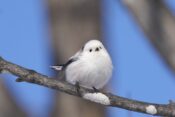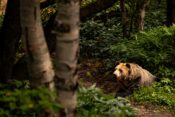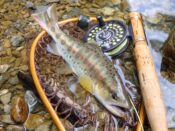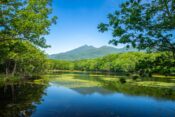エゾオオカミ:北海道に生息していた幻の絶滅種
エゾオオカミは,かつて北海道に生息していた日本固有のオオカミで,日本に存在した2つのオオカミの亜種の1つです。エゾオオカミは本州などに生息していたニホンオオカミに比べ,体が大きく,より寒冷な環境に適応していました。しかし,明治時代に入ってから開拓が進む中で農業被害が増加し,駆除の対象とされたことから,20世紀初頭に絶滅したとされています。現在では,エゾオオカミに関する資料や痕跡を探すことができますが,彼らが生きていた当時の自然環境や生態系の変化に思いを馳せることも大切です。(写真は,同じオオカミの仲間であるヨーロッパオオカミの写真を使っています〜以下同じ〜)
*“エゾオオカミ”は、環境省のレッドリストによると「絶滅(EX:Extinct)」とされています。
*“エゾオオカミ”については、他のブログもあります。「エゾオオカミ:北海道の幻の捕食者と絶滅を防ぐための教訓」です。併せて読んでください。
エゾオオカミの特徴と歴史
エゾオオカミは,北海道の広大な森林や山岳地帯に生息していた野生動物です。体長は1.5メートルほどで,オオカミとしては大型の部類に入ります。狩りの際には,エゾシカなどの大きな草食動物を主な獲物としていたため,群れで協力して狩りをすることが多かったと考えられています。
- 絶滅の背景:エゾオオカミが絶滅した主な原因は,開拓者による駆除と生息環境の破壊です。開拓が進み,畑や牧場が増えるにつれて,家畜への被害が問題視され,エゾオオカミは害獣として扱われるようになりました。また,エゾシカの減少もエゾオオカミの食糧不足を招き,彼らの生態系に大きな影響を与えたとされています。
- エゾオオカミの痕跡:現在,エゾオオカミの実物を見ることはできませんが,北海道各地の博物館や資料館でエゾオオカミの剥製や骨,記録資料を見ることができます。特に,旭川市博物館や北海道大学総合博物館では,エゾオオカミに関する詳しい展示があり,その生態や歴史を学ぶことができます。
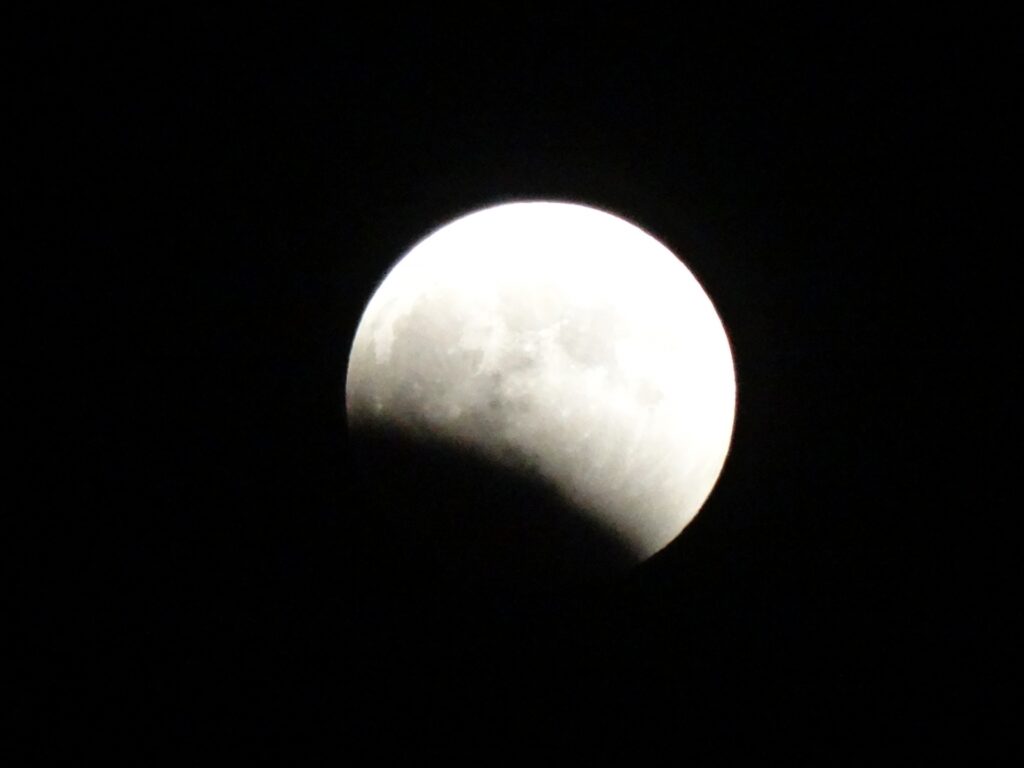
エゾオオカミゆかりの地を巡る観光
エゾオオカミがかつて生息していた北海道の大自然を感じるには,いくつかのエリアを訪れるのがおすすめです。エゾオオカミの足跡をたどる旅は,北海道の豊かな自然や生態系に触れる良い機会でもあります。
- 大雪山国立公園:エゾオオカミが生息していたとされる広大な森林と山岳地帯です。現在でもエゾシカやヒグマ,キタキツネなどの野生動物が多く生息しており,エゾオオカミがかつて暮らしていた環境を想像することができます。大雪山ではトレッキングや自然観察が楽しめるため,野生動物や植物に興味がある旅行者におすすめです。
- 釧路湿原:日本最大の湿原である釧路湿原も,エゾオオカミの生息地の一つだったと考えられています。広大な湿原とその周辺には,タンチョウやオジロワシなどの希少な動物が多く生息しており,湿原を歩きながらエゾオオカミの足跡に思いを馳せることができます。カヌーでの湿原探検ツアーや自然ガイド付きの散策ツアーが人気です。
アクセス情報
エゾオオカミゆかりの地にアクセスする際は,北海道内の主要都市から公共交通機関やレンタカーを利用すると便利です。
- 旭川市博物館へのアクセス:旭川市は,札幌からJRで約1時間半でアクセス可能です。博物館は旭川市内にあり,駅からバスやタクシーで約15分で到着します。
- 大雪山国立公園へのアクセス:旭川空港から車で約1時間,または旭川市内からバスで約2時間でアクセスできます。山岳地帯へのトレッキングや自然散策を楽しむには,車でのアクセスが便利です。
- 釧路湿原へのアクセス:釧路空港から車で約30分,またはJR釧路駅から湿原観光バスでアクセスできます。湿原を巡る観光ツアーも豊富に用意されています。
宿泊情報
エゾオオカミゆかりの地を巡る旅では,周辺の自然を満喫できる宿泊施設がおすすめです。温泉旅館やペンション,ホテルなど,旅のスタイルに合わせて選ぶことができます。
- 温泉宿でリラックス:大雪山国立公園周辺や釧路湿原近くには,温泉宿が点在しています。特に,大雪山周辺の「層雲峡温泉」や釧路湿原近くの「阿寒湖温泉」などは,豊かな自然とともに温泉を楽しむことができます。
- エコロッジやペンション:自然を身近に感じながら宿泊したい方には,エコロッジやペンションがおすすめです。大雪山や釧路湿原の近くには,環境に配慮したエコロッジや自然体験ができるペンションがあり,野鳥観察やガイド付きトレッキングなども楽しめます。
周辺のグルメとアクティビティ
エゾオオカミの痕跡をたどりながら,北海道の美味しい食事やアクティビティも一緒に楽しみましょう。
- 北海道グルメ:旭川では,地元の野菜や牛肉,海鮮を使った料理が楽しめます。特に,旭川ラーメンは濃厚な醤油スープが特徴で,一度は味わってみたい一品です。また,釧路では新鮮な魚介類を使った炉端焼きや海鮮丼,阿寒湖では名物のマリモ料理が人気です。
- 自然アクティビティ:大雪山国立公園や釧路湿原周辺では,トレッキング,カヌー,バードウォッチングなど多彩なアクティビティが楽しめます。夏は登山やハイキング,冬はスノーシューやスキーで,四季折々の自然を満喫できます。
まとめ
エゾオオカミは,北海道の自然の中で長い間生息していた幻の絶滅種です。エゾオオカミが暮らしていた大雪山や釧路湿原を訪れることで,彼らが生きていた時代の自然環境や生態系を感じることができます。また,周辺の観光スポットやグルメ,アクティビティも併せて楽しむことで,より深く北海道の魅力を味わうことができるでしょう。ぜひ,エゾオオカミの足跡をたどる旅を計画してみてください。
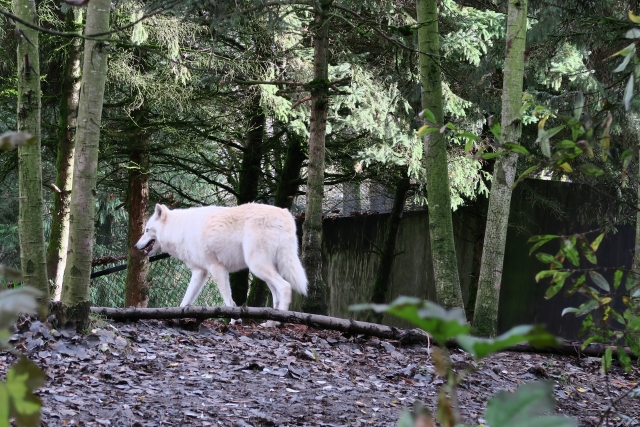
Ezo Wolf: The Extinct Species That Once Roamed Hokkaido
The Ezo Wolf was a species of wolf unique to Japan that once inhabited Hokkaido. It was one of the two subspecies of wolves found in Japan, with the Ezo Wolf being larger and more adapted to the colder climate than the Japanese Wolf, which lived in Honshu and other areas. However, due to human expansion and hunting, the Ezo Wolf was considered a threat to livestock and was driven to extinction in the early 20th century. Today, visitors can learn about the Ezo Wolf through exhibits and remnants, reflecting on the changes in Hokkaido’s natural environment and ecosystem.
Characteristics and History of the Ezo Wolf
The Ezo Wolf inhabited Hokkaido’s expansive forests and mountainous regions. Measuring about 1.5 meters in length, it was larger than the average wolf. The Ezo Wolf primarily preyed on large herbivores like Ezo deer, and it likely hunted in packs to take down such prey.
- Causes of Extinction: The primary reasons for the Ezo Wolf’s extinction were human hunting and habitat destruction. As settlers expanded agriculture and created pastures, the Ezo Wolf began to be seen as a pest, leading to large-scale extermination. The decline in the Ezo deer population also caused a shortage of food for the wolves, impacting their survival.
- Remnants of the Ezo Wolf: While it is no longer possible to see live Ezo Wolves, you can find taxidermy specimens, bones, and records in museums throughout Hokkaido. Notable places include the Asahikawa City Museum and the Hokkaido University Museum, which have detailed exhibits on the Ezo Wolf’s ecology and history.
Exploring Sites Associated with the Ezo Wolf
To experience the natural landscapes that the Ezo Wolf once roamed, visiting several regions in Hokkaido is recommended. A journey tracing the Ezo Wolf’s footprints allows you to connect with Hokkaido’s rich nature and ecosystems.
- Daisetsuzan National Park: This vast forest and mountainous area was once home to the Ezo Wolf. Even today, wild animals such as Ezo deer, brown bears, and red foxes inhabit the park, offering a glimpse into the environment where the Ezo Wolf once lived. Daisetsuzan is an excellent destination for trekking and wildlife observation, appealing to nature enthusiasts.
- Kushiro Marshland: The largest marshland in Japan, Kushiro Marshland, was also one of the Ezo Wolf’s habitats. The vast wetland is home to rare animals like red-crowned cranes and white-tailed eagles. Walking through the marshland, you can imagine the Ezo Wolf’s presence in this unique ecosystem. Canoe tours and guided nature walks are popular activities.
Access Information
Accessing the areas associated with the Ezo Wolf is convenient with public transportation or a rental car from Hokkaido’s major cities.
- Access to Asahikawa City Museum: Asahikawa is about 1.5 hours by JR train from Sapporo. The museum is located within the city and is about a 15-minute bus or taxi ride from Asahikawa Station.
- Access to Daisetsuzan National Park: From Asahikawa Airport, Daisetsuzan is about a 1-hour drive, or around 2 hours by bus from Asahikawa City. For trekking and nature exploration, traveling by car is recommended.
- Access to Kushiro Marshland: From Kushiro Airport, it’s about a 30-minute drive, or you can take a sightseeing bus from JR Kushiro Station. Numerous marshland tours are available to explore the area.
Accommodation Options
When traveling to sites associated with the Ezo Wolf, staying in accommodations that allow you to fully appreciate the surrounding nature is ideal. There are onsen ryokan (hot spring inns), pensions, and hotels to suit your travel style.
- Relax in Onsen Inns: Onsen inns are scattered around Daisetsuzan National Park and near Kushiro Marshland. In particular, “Sounkyo Onsen” near Daisetsuzan and “Lake Akan Onsen” close to Kushiro Marshland offer opportunities to enjoy hot springs amidst beautiful natural surroundings.
- Eco-Lodges and Pensions: For those who want a closer experience with nature, eco-lodges and pensions are recommended. Near Daisetsuzan and Kushiro Marshland, you can find environmentally-friendly lodges offering activities like birdwatching and guided trekking.
Local Cuisine and Activities
While tracing the Ezo Wolf’s history, don’t miss the chance to enjoy Hokkaido’s delicious food and various activities.
- Hokkaido Gourmet: In Asahikawa, you can savor dishes made with local vegetables, beef, and seafood. “Asahikawa Ramen” is a must-try dish, featuring a rich soy sauce-based broth. In Kushiro, fresh seafood dishes like robatayaki (Japanese-style barbecue) and seafood bowls are popular, while Lake Akan is known for its unique marimo cuisine.
- Nature Activities: Around Daisetsuzan National Park and Kushiro Marshland, there are plenty of activities to enjoy, including trekking, canoeing, and birdwatching. You can explore the great outdoors in every season, from hiking and climbing in summer to snowshoeing and skiing in winter.
Conclusion
The Ezo Wolf was a mysterious species that once thrived in Hokkaido’s natural environment. By visiting Daisetsuzan National Park and Kushiro Marshland, you can gain a sense of the ecosystems and landscapes that the Ezo Wolf inhabited. Along with sightseeing, local gourmet, and activities, you can experience the deeper charm of Hokkaido. Plan a journey to follow in the footsteps of the Ezo Wolf and immerse yourself in the beauty of Hokkaido’s nature and culture.

